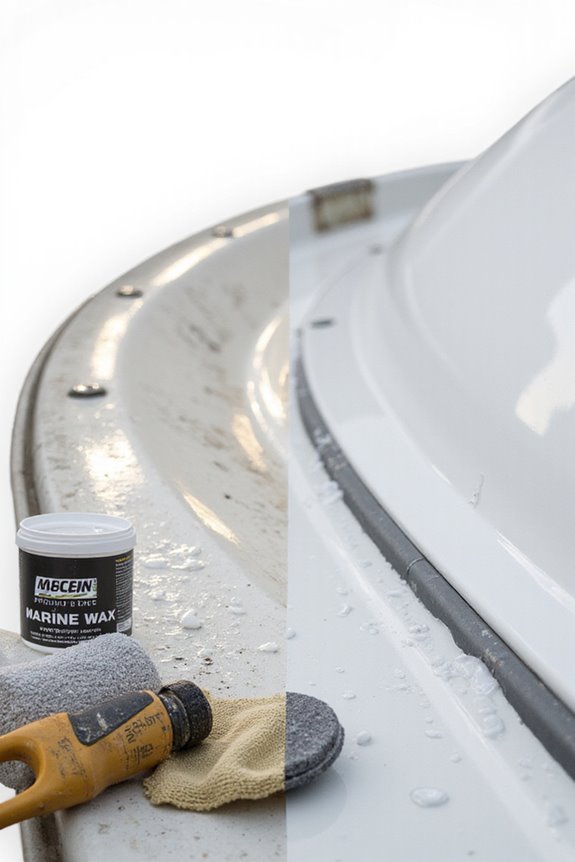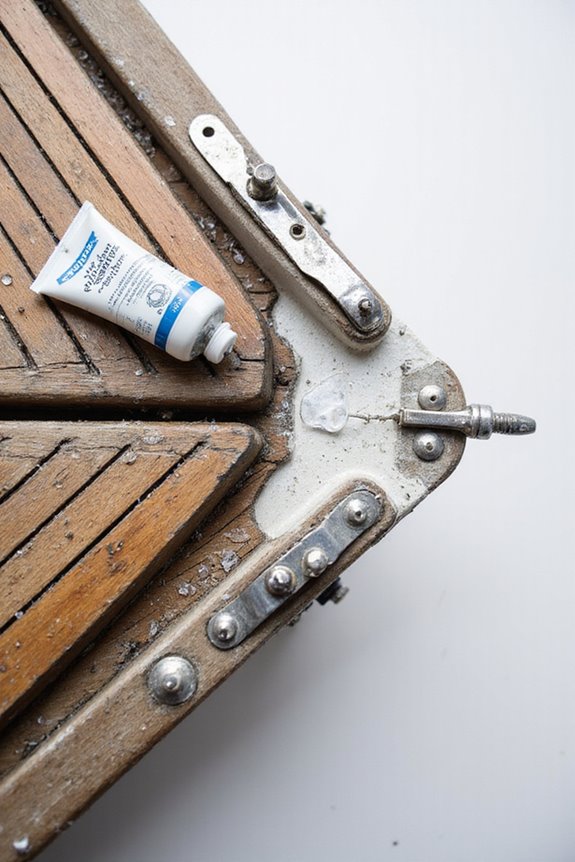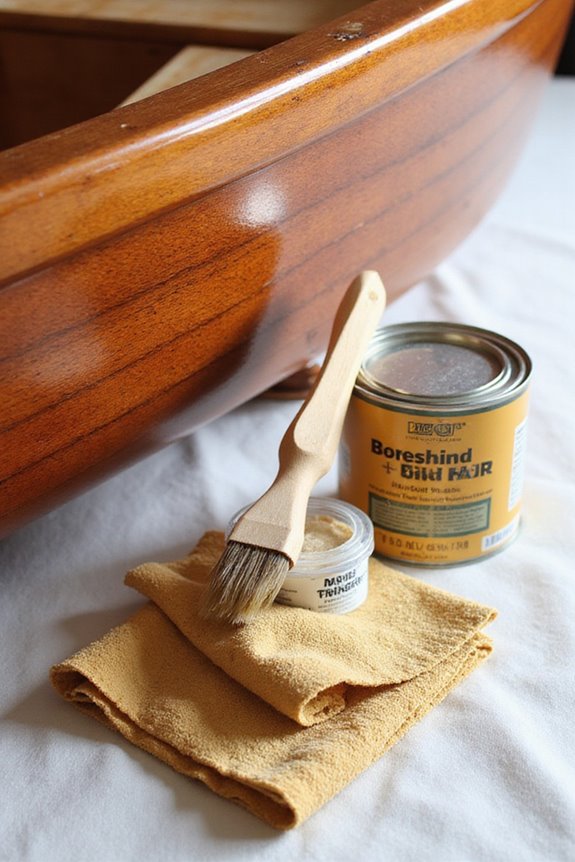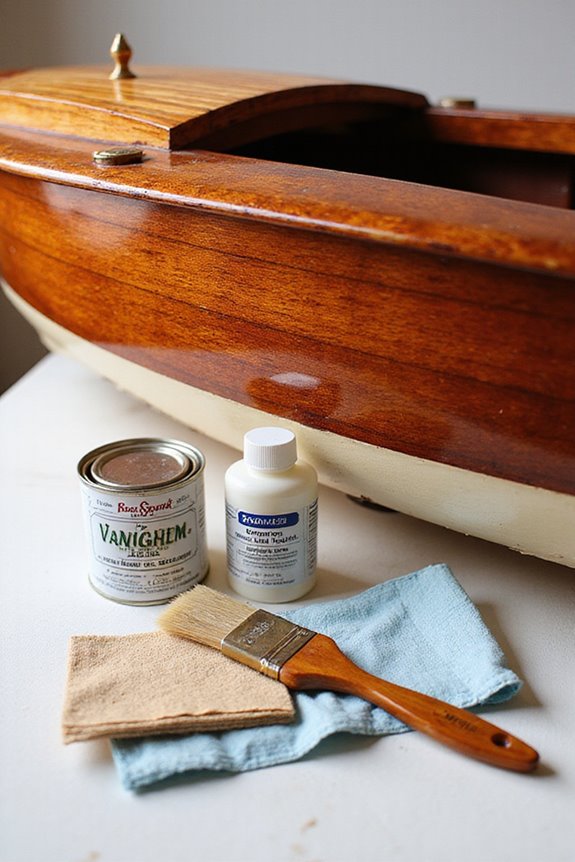We understand your boat deserves more than just a quick rinse, so let’s start by clearing everything off and using marine-specific soaps to avoid damage. Stubborn stains, waterline marks, and oxidation? A good scrub with stiff brushes and some elbow grease goes a long way. After that, polishing with rubbing compounds and applying marine-grade wax or sealant protects against UV rays and salty spray. Ready for a gleaming finish that lasts? Keep going—there’s more to learn about making your boat truly shine.
Key Takeaways
- Start by thoroughly rinsing and cleaning the boat with marine-specific soap to remove dirt and prevent damage to the gel coat.
- Use a stiff-bristle brush and specialized cleaners to effectively remove stains and rust marks along the waterline.
- Polish the gel coat using a rubbing compound and buffer with wool or synthetic pads to remove oxidation and swirl marks.
- Apply thin, even coats of marine-grade wax or polymer sealant for long-lasting UV protection and a glossy finish.
- Perform a final inspection to address missed spots, buff wax for uniform shine, and maintain hardware and windows accordingly.
Preparing Your Boat’s Exterior for Detailed Cleaning
Before we immerse ourselves in the suds and shine, let’s talk about setting the stage for a flawless boat detailing session. First, we need to clear out all personal items from the boat’s interior and exterior, making sure storage compartments aren’t hiding any dampness or dirt—that clutter can really slow us down. Got your favorite cleaning products ready? Great! But remember, choosing marine-specific soaps and gentle cleaners protects your boat’s finish and avoids unwanted damage. How about where to work? Boat storage under shade is ideal—it prevents soaps and waxes from drying too quickly, which leads to streaks nobody wants. Plus, ample space to move means we won’t feel cramped or accidentally knock something valuable. Ready to start? Proper prep makes all the difference before we delve into the cleaning itself.
Effective Cleaning Techniques for a Pristine Finish
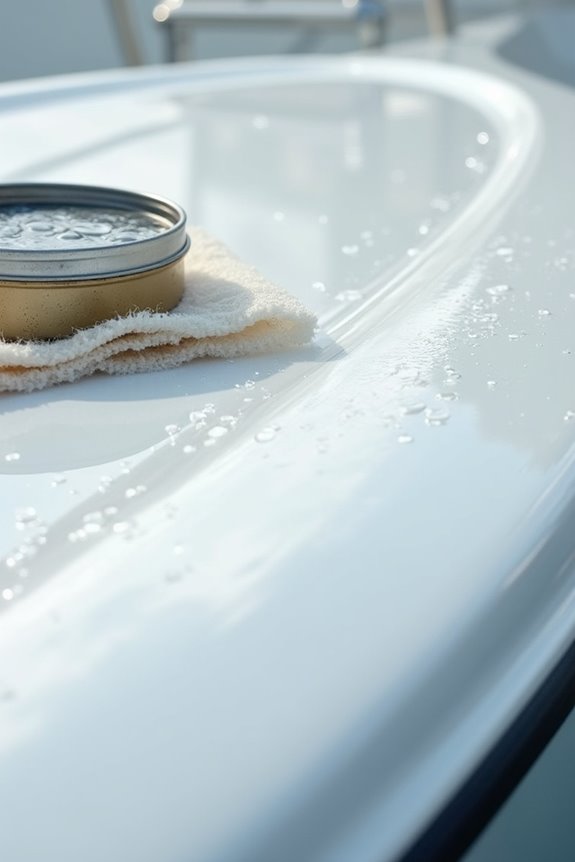
While cleaning a boat’s exterior might seem straightforward, getting that pristine, showroom shine requires some thoughtful techniques and the right products. First off, our brush selection is key: stiff-bristle brushes work great on stubborn dirt but must suit gel coats to prevent scratches. Ever struggled with waterline stains or rust marks? Tackling stain removal promptly using specialized cleaners, like rust removers or black streak removers, keeps those pesky blemishes from settling in. Don’t forget to rinse thoroughly—soap residue can attract dirt, undoing all your hard work. Using marine-specific soaps, especially “wash ‘n wax” types, saves time by cleaning and protecting simultaneously. With some elbow grease and the right tools, we can keep our boats shining and ready for the next adventure—doesn’t that sound like a win?
Polishing and Correcting the Gel Coat Surface
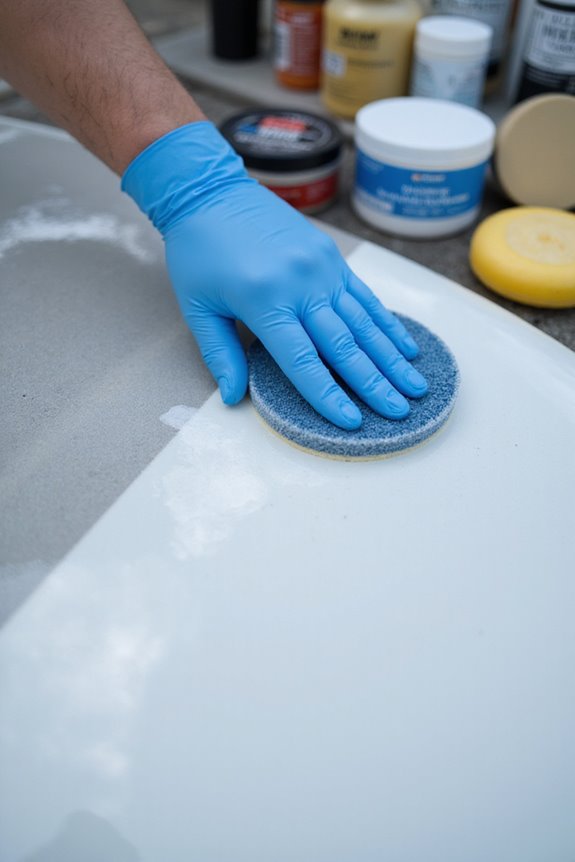
Even though washing our boats gets rid of dirt and grime, it doesn’t always restore that deep shine we love—that’s where polishing and correcting the gel coat surface comes in. Gel coat restoration starts with removing oxidation using a rubbing compound and a wool or synthetic pad—think of it as giving your boat’s skin a fresh canvas. We use circular motions with a buffer for even cutting but watch out: going too deep can be like sanding through your favorite t-shirt! After compounding, polishing techniques step in to erase swirl marks, leaving the surface glassy smooth using softer foam pads at low to medium speed. It’s a bit of an art, but when we nail it, our boats gleam like new, ready for the sun and sea.
Choosing and Applying Marine-Grade Wax and Sealants
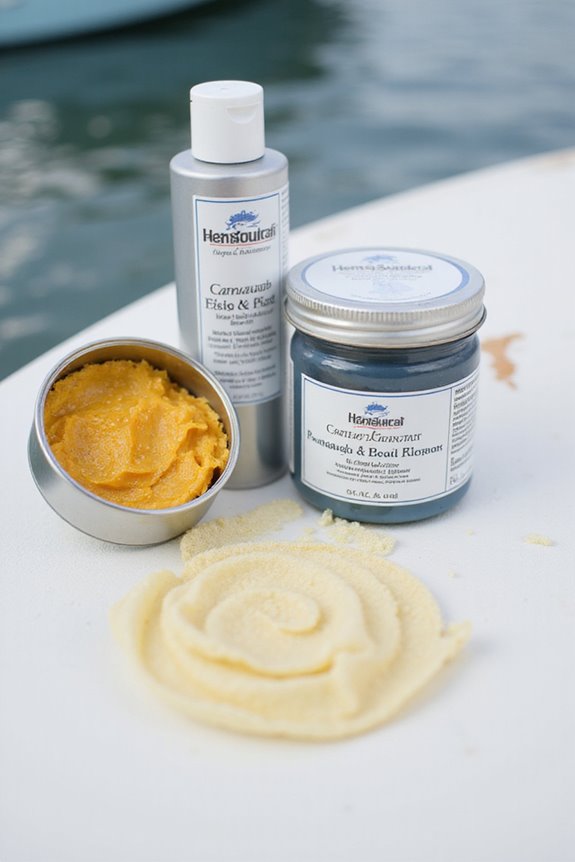
As we move past polishing, it’s time to talk about the real heroes of boat protection—marine-grade waxes and sealants. Choosing between natural carnauba or synthetic marine waxes means balancing that deep gloss against durability. Don’t forget cleaner waxes for a quick refresh and specialty types that fight harsh sun and salt. When it comes to sealant application, polymer-based products bond at the molecular level, giving you long-lasting UV and oxidation defense, while spray sealants offer quick maintenance magic. The key? Clean and dry your surface first, then apply thin, even coats. Let each layer haze before buffing to a shine. Why settle? Layer a sealant beneath wax for the best of both worlds—durability meets eye candy, keeping our boat looking sharp and protected through every season.
Protecting Your Boat With Advanced Coatings
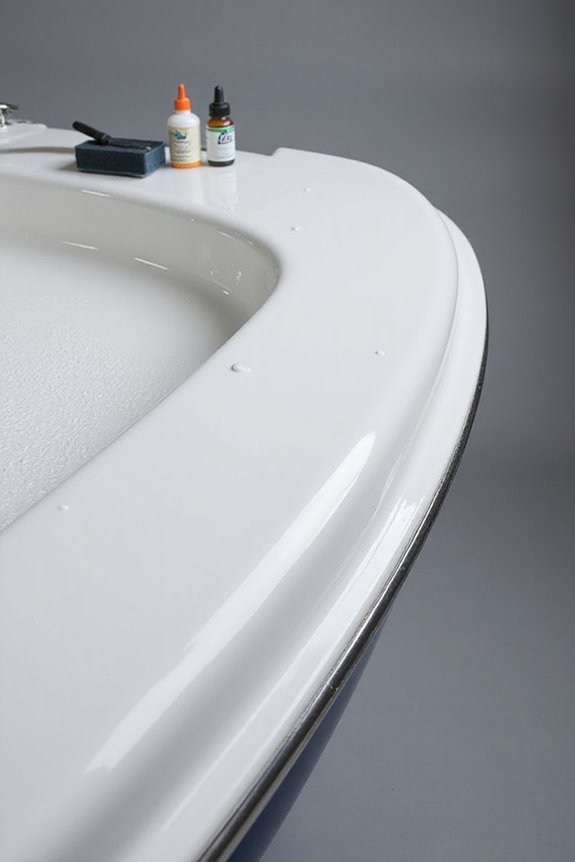
If you’re serious about keeping your boat in top shape, advanced coatings are the secret weapons you might not have tried yet. These high-tech layers, like silane-siloxane and nano-ceramics, create tough, long-lasting surfaces that resist scratches, UV rays, and even corrosion. Plus, they offer eco friendly protection without harming the water or marine life—a win for us all, right? Beyond durability, some coatings reduce hull drag, which can save fuel and boost speed. Imagine cutting trips to the pump while helping the planet! They also keep pesky barnacles and algae at bay, so your boat looks sharp and sails smoothly. With these coatings, you get strength, sustainability, and less hassle—a combo every boat owner can appreciate. Ready to upgrade your protection game?
Maintaining the Underwater Hull for Optimal Performance
While we all love the freedom of the open water, our boats don’t share that enthusiasm for unwanted hitchhikers—marine growth like algae, barnacles, and seaweed. Hull fouling slows us down, sometimes cutting speed by up to 30%, and nobody wants to pay extra at the pump because of that, right? Cleaning frequency is key: a monthly scrub keeps the hull and propellers slick and efficient, restoring up to 98% of our boat’s original speed. We recommend balancing cleaning schedules with your local water conditions and paint type to avoid peeling off protective coatings prematurely. Tools like scrapers and scouring pads help tackle the “jungle” beneath, while careful cleaning protects delicate surfaces and keeps fuel costs from sneaking up on us. Ready to shave those drag pounds?
Caring for Canvas Tops and Upholstery During Detailing
Cleaning and maintaining the underwater hull does wonders for performance, but what about the parts of our boat that catch eyes instead of seaweed? Canvas tops and upholstery deserve the same attention to keep them looking crisp and lasting longer. For effective canvas maintenance, we hose off dirt and bird droppings after each trip, using mild soap and a soft brush occasionally. Don’t forget to rinse well and air dry to prevent mold and mildew—nobody wants that musty smell! When caring for upholstery, marine-specific cleaners and conditioners work best to avoid cracking or fading. Applying UV-blocking sprays on both canvas and upholstery not only preserves color but also extends lifespan. Together, these simple steps boost both deck appeal and resale value. After all, isn’t a boat that shines from top to bottom what we all aim for?
Final Inspection and Touch-Ups for a Showroom Shine
Before we call it a day, let’s give the boat a thorough once-over to catch anything that might’ve slipped past earlier steps—because nobody wants to cruise with dull spots or stubborn fingerprints spoiling that fresh wax job. Our final quality control involves using a detailed inspection checklist to scan fiberglass, metal fittings, and glass for scratches, rust, streaks, or water spots. We reapply wax on any patchy areas, wipe off residues with microfiber towels, and buff surfaces to a uniform shine. Don’t forget to polish metal hardware and apply water repellents like Rain-X on windows for that crystal-clear view. Ultimately, we document everything—photos and notes—to track condition over time and plan the next detailing. Who doesn’t want their boat looking showroom-ready every time?
Frequently Asked Questions
How Often Should I Detail and Wax My Boat for Best Results?
For the best results, our detailing frequency should be at least once a year, while our waxing schedule depends on use—every 3 months if we’re in sun or saltwater, otherwise every 6 to 12 months keeps us protected.
What Tools Are Best for Removing Stubborn Rust Stains?
Like finding the right key for a stubborn lock, we’ve learned that the best cleaning tools for rust stain removal include soft brushes, microfiber cloths, and specialized cleaners—together, they release sparkling surfaces without damage.
Can I Use Household Waxes Instead of Marine-Grade Wax?
We wouldn’t recommend using household waxes instead of marine grade wax. While cheaper, household waxes lack protection against UV rays and saltwater, risking damage. Let’s stick together and choose marine-grade wax for lasting, reliable boat care.
How Do I Safely Store Waxed Boats During the Off-Season?
For safe boat storage during winter preparation, let’s cover our boats with quality covers and store them indoors if possible. We’ll guarantee dryness, ventilation, and remove batteries to protect our wax and hull through the off-season together.
Are There Eco-Friendly Alternatives to Traditional Boat Cleaning Products?
Yes, we can definitely choose biodegradable cleaners and natural solutions to keep our boats spotless while protecting waterways. By using these eco-friendly options, we’re part of a community committed to preserving the environment for all of us.

